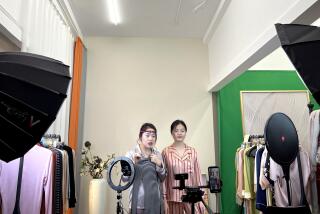Try Hong Kong for Super, Soft Silks : Fashionable camisoles, slips and other quality garments made in China are a real bargain.
- Share via
HONG KONG — There is nothing like the feel of silk against the skin or of skin through silk, for that matter. The soft glow of it, even if glimpsed only in your own mirror, and the warmth of the animal fiber--so different from the cold, slick touch of synthetics--provide a satisfying foundation for the day’s or evening’s activities. Wearing a silk blouse intercepted by nylon and polyester underthings just doesn’t do the trick.
The silk underwear sold in the shops of Hong Kong, and made in China, is a shopper’s dream. It is fashionable, well-made and a relative bargain. Perhaps most importantly, it’s crafted with the kind of workmanship not usually found in the U.S. Much of the best of it comes from Shanghai.
Developed as an international trading city in the late 1800s, Shanghai was for a long time China’s most Westernized city, supplying foreigners and Chinese alike with the finest in handmade clothing. Following the 1949 Communist revolution, the styles changed to somber-hued pajamas and gray serge Mao jackets. There was not enough work to keep Shanghai’s custom tailors in business.
During the succeeding decades, a number of them emigrated to Hong Kong, where they are now counted among the best tailors in the city. Yet Shanghai managed to maintain its market for silk underwear, hand-embroidered silk blouses and bed and table-linens, at least in part because they are highly transportable and do not depend on multiple custom fittings for perfection. And so Hong Kong shops--particularly the numerous branches of mainland Chinese department stores--blossom with silk underwear in varying degrees of quality and charm.
The women’s market has a monopoly on variety and excitement in silk underwear here. The range is limited for men, who can do better in the United States.
In Hong Kong, the place to shop for silk underwear is in department stores, not small shops. And the overwhelming majority of stock in the department stores is in sets of camisoles and pants. Clearly, the Chinese manufacturers have directed the talents of their design staffs in this direction.
Some stores offer a rich variety of shapes and decorative styles, ranging from simple overcast edges to hand-embroidery, lace-like patterned work to appliques in flowery or Art Deco-flavored geometric patterns and colors. There is usually a smaller selection of pants sold separately, from string bikinis to flouncing tap pants in crepe-backed satin, crepe de chine and silk jersey.
Full slips are much harder to come by and the selection is usually limited in color and style. Slips are often not as flattering or as up-to-date as the camisole sets. Yet once in a while a real beauty emerges. Half slips, too, are scarce and unimaginative, but basics sometimes show up in black, white or maybe light blue in a standard length, which seems to be just below the knees. Sexy, softly constructed bras are usually sold in sets with abbreviated tap pants and come in a wider variety of colors.
The fabric of choice these days is crepe-backed satin--sometimes called “charmeuse”--which has the slicked, glossy surface of satin with the softness and drape of crepe silk. But occasional novelty fabrics crop up, too, such as figured fabric in which the background is satin and a repeated design (of polka dots or hearts, say) appears in crepe or another textured silk.
I looked and looked for crepe de chine, a very delicate, lightweight crepe, but it is either considered too old-fashioned for today’s customer or, for some reason, the fabric itself is not readily available to manufacturers. I found precious few examples.
Workmanship, in general, is consistently good. Look for quality items cut on the bias--the diagonal grain of the fabric--for extra give. Another sign of quality is seams that are double-sewn. (The desirable French seams are sewn once with the raw edges on the outside, then sewn again like a regular seam with the first seam enclosed, leaving no raw edges exposed.)
Alas, the days of the entirely handmade slip--with French seams of tiny hand-sewn stitches and occasional faint pencil marks that served as underdrawings for the embroiderer--may be gone forever, unless you have your clothing custom-made. In fact, the only things I found with hand-sewn seams were a few slips in crepe de chine in which the fabric, workmanship and style all suggested that the pieces were old stock, made in earlier days. The Chinese make their silk underwear to last. I have found it to be comparable in quality to silk underwear sold under U.S. labels. Seams and fabric hold up well even when subjected to vigorous activity. A satin slip I have worn hard since November, 1987, shows no signs of wear.
Among the mainland Chinese department stores I explored during my most recent stay in Hong Kong last January, I found the best and largest selection of silk underwear at the Star House branch of Chinese Arts & Crafts (HK) Ltd. (CAC) on Kowloon. A bewildering array of camisole sets meets the eye, averaging $36-$38 in price.
After trying on half a dozen camisole sets in various sizes, I selected a blue set with embroidered and open-work leaves and flowers at the neckline. (CAC has adequate dressing-room facilities.) There tends to be a wider selection in small sizes (P, S and M), but larger sizes (L and XL) can be found with a little searching. Garments are true to size, and I have had no problem with shrinkage.
Pants range from $7 to $16, depending on the style and amount of embroidery. A pair in mint-green satin, consisting solely of deeply overlapping petals, was just right for a friend. At the lower end of the price range were silk jersey or crepe de chine bikinis.
Yue Hwa, also on Kowloon, had the double disadvantage of a smaller selection and a no-try-on policy for underwear, but some of their camisole sets, in standard colors of black, white, pink or peach, had unusually beautiful embroidery ($40). Also lovely were a few entirely hand-sewn crepe de chine slips ($27) with delicate floral embroidery in a silvery gray-beige, as well as black and peach, but in limited sizes. (These were the only hand-stitched slips I found in Hong Kong.) Nearby, there was a cramped cubicle for trying on blouses, and I resorted to the strategy of removing my own slip, then comparing it to one I fancied.
Try also Chung Kiu Chinese Products Emporium. Its selection is much more limited than those of the other two stores but it is sometimes possible to find hand-sewn pieces there in traditional styles. I found slips in crepe de chine with hand-sewn seams that may have been old stock, but seemed handiwork treasures, just the same.
The variety of silks in Hong Kong can keep you busy for days.
GUIDEBOOK: Stalking Silks
The following stores carry a wide range of silk underwear products:
Chinese Arts & Crafts (HK) Ltd., Star House, Tsim Sha Tsui district, Kowloon. To the left as you disembark from the Star Ferry. Open weekdays 10 a.m.-6:30 p.m., Sundays noon-6 p.m.; telephone locally 735-4061.
Yue Hwa Chinese Products Emporium, 301-9 Nathan Road, Yau Ma Tei district, Kowloon. Corner of Jordan and Nathan roads, near the Jordan subway station and Newport Cinema. Open daily 10 a.m.-10 p.m.; 384-0084.
Chung Kiu Chinese Products Emporium, 17 Hankow Road, Tsim Sha Tsui district, Kowloon. At the corner of Hankow and Peking roads, about two blocks west of the Hyatt Regency hotel on Peking Road. Open daily 9:30 a.m.-8:30 p.m.; 376-1911.
More to Read
Sign up for The Wild
We’ll help you find the best places to hike, bike and run, as well as the perfect silent spots for meditation and yoga.
You may occasionally receive promotional content from the Los Angeles Times.





